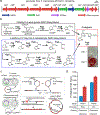Stepwise genetic engineering of Pseudomonas putida enables robust heterologous production of prodigiosin and glidobactin A
- PMID: 34175462
- PMCID: PMC8434984
- DOI: 10.1016/j.ymben.2021.06.004
Stepwise genetic engineering of Pseudomonas putida enables robust heterologous production of prodigiosin and glidobactin A
Abstract
Polyketide synthases (PKS) and nonribosomal peptide synthetases (NRPS) comprise biosynthetic pathways that provide access to diverse, often bioactive natural products. Metabolic engineering can improve production metrics to support characterization and drug-development studies, but often native hosts are difficult to genetically manipulate and/or culture. For this reason, heterologous expression is a common strategy for natural product discovery and characterization. Many bacteria have been developed to express heterologous biosynthetic gene clusters (BGCs) for producing polyketides and nonribosomal peptides. In this article, we describe tools for using Pseudomonas putida, a Gram-negative soil bacterium, as a heterologous host for producing natural products. Pseudomonads are known to produce many natural products, but P. putida production titers have been inconsistent in the literature and often low compared to other hosts. In recent years, synthetic biology tools for engineering P. putida have greatly improved, but their application towards production of natural products is limited. To demonstrate the potential of P. putida as a heterologous host, we introduced BGCs encoding the synthesis of prodigiosin and glidobactin A, two bioactive natural products synthesized from a combination of PKS and NRPS enzymology. Engineered strains exhibited robust production of both compounds after a single chromosomal integration of the corresponding BGC. Next, we took advantage of a set of genome-editing tools to increase titers by modifying transcription and translation of the BGCs and increasing the availability of auxiliary proteins required for PKS and NRPS activity. Lastly, we discovered genetic modifications to P. putida that affect natural product synthesis, including a strategy for removing a carbon sink that improves product titers. These efforts resulted in production strains capable of producing 1.1 g/L prodigiosin and 470 mg/L glidobactin A.
Keywords: Genome editing; Heterologous expression; Non-ribosomal peptide; Polyketide; Pseudomonas putida.
Copyright © 2021 International Metabolic Engineering Society. Published by Elsevier Inc. All rights reserved.
Conflict of interest statement
Conflicts of Interest
The authors declare no conflicts of interest.
Figures





Similar articles
-
Pseudomonas putida rDNA is a favored site for the expression of biosynthetic genes.Sci Rep. 2019 May 7;9(1):7028. doi: 10.1038/s41598-019-43405-1. Sci Rep. 2019. PMID: 31065014 Free PMC article.
-
Broad-Host-Range Expression Reveals Native and Host Regulatory Elements That Influence Heterologous Antibiotic Production in Gram-Negative Bacteria.mBio. 2017 Sep 5;8(5):e01291-17. doi: 10.1128/mBio.01291-17. mBio. 2017. PMID: 28874475 Free PMC article.
-
Protocols for RecET-based markerless gene knockout and integration to express heterologous biosynthetic gene clusters in Pseudomonas putida.Microb Biotechnol. 2020 Jan;13(1):199-209. doi: 10.1111/1751-7915.13374. Epub 2019 Feb 14. Microb Biotechnol. 2020. PMID: 30761747 Free PMC article.
-
Pseudomonas putida-a versatile host for the production of natural products.Appl Microbiol Biotechnol. 2015 Aug;99(15):6197-214. doi: 10.1007/s00253-015-6745-4. Epub 2015 Jun 23. Appl Microbiol Biotechnol. 2015. PMID: 26099332 Free PMC article. Review.
-
Challenges of functional expression of complex polyketide biosynthetic gene clusters.Curr Opin Biotechnol. 2021 Jun;69:103-111. doi: 10.1016/j.copbio.2020.12.007. Epub 2021 Jan 7. Curr Opin Biotechnol. 2021. PMID: 33422913 Review.
Cited by
-
Growth Kinetics of Prodigiosin (Food Color) Produced by Novel Serratia marcescens bhu prodig Under Submerged Fermentation (SMF).Mol Biotechnol. 2025 Aug;67(8):3175-3185. doi: 10.1007/s12033-023-00925-6. Epub 2023 Nov 1. Mol Biotechnol. 2025. PMID: 37907812
-
Prodigiosin: unveiling the crimson wonder - a comprehensive journey from diverse bioactivity to synthesis and yield enhancement.Front Microbiol. 2024 Jun 5;15:1412776. doi: 10.3389/fmicb.2024.1412776. eCollection 2024. Front Microbiol. 2024. PMID: 38903802 Free PMC article. Review.
-
Development of a bacterial gene transcription activating strategy based on transcriptional activator positive feedback.J Adv Res. 2024 Dec;66:155-164. doi: 10.1016/j.jare.2023.12.015. Epub 2023 Dec 18. J Adv Res. 2024. PMID: 38123018 Free PMC article.
-
Establishing a straightforward I-SceI-mediated recombination one-plasmid system for efficient genome editing in P. putida KT2440.Microb Biotechnol. 2024 Jul;17(7):e14531. doi: 10.1111/1751-7915.14531. Microb Biotechnol. 2024. PMID: 39031514 Free PMC article.
-
Synthetic Biology Toolbox for Nitrogen-Fixing Soil Microbes.ACS Synth Biol. 2023 Dec 15;12(12):3623-3634. doi: 10.1021/acssynbio.3c00414. Epub 2023 Nov 21. ACS Synth Biol. 2023. PMID: 37988619 Free PMC article.
References
Publication types
MeSH terms
Substances
Grants and funding
LinkOut - more resources
Full Text Sources
Research Materials
Miscellaneous

